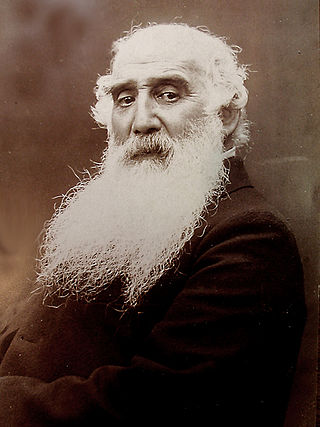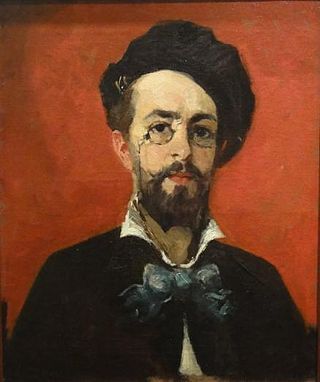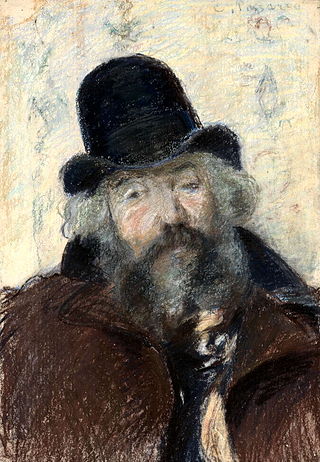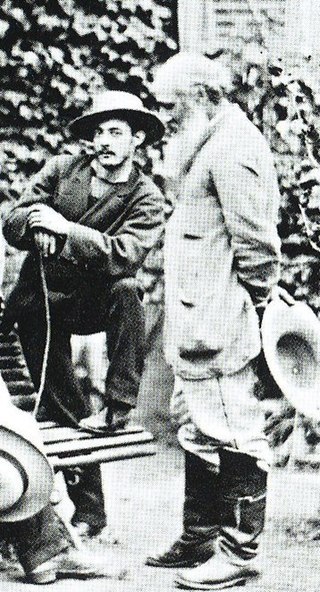
Oscar-Claude Monet was a French painter and founder of impressionist painting who is seen as a key precursor to modernism, especially in his attempts to paint nature as he perceived it. During his long career, he was the most consistent and prolific practitioner of impressionism's philosophy of expressing one's perceptions before nature, especially as applied to plein air (outdoor) landscape painting. The term "Impressionism" is derived from the title of his painting Impression, soleil levant, exhibited in 1874 initiated by Monet and his associates as an alternative to the Salon.

Jacob Abraham Camille Pissarro was a Danish-French Impressionist and Neo-Impressionist painter born on the island of St Thomas. His importance resides in his contributions to both Impressionism and Post-Impressionism. Pissarro studied from great forerunners, including Gustave Courbet and Jean-Baptiste-Camille Corot. He later studied and worked alongside Georges Seurat and Paul Signac when he took on the Neo-Impressionist style at the age of 54.

Impressionism was a 19th-century art movement characterized by relatively small, thin, yet visible brush strokes, open composition, emphasis on accurate depiction of light in its changing qualities, ordinary subject matter, unusual visual angles, and inclusion of movement as a crucial element of human perception and experience. Impressionism originated with a group of Paris-based artists whose independent exhibitions brought them to prominence during the 1870s and 1880s.

En plein air, or plein-air painting, is the act of painting outdoors.

Auvers-sur-Oise is a commune in the department of Val-d'Oise, on the northwestern outskirts of Paris, France. It is located 27.2 km (16.9 mi) from the centre of Paris. It is associated with several famous artists, the most prominent being Vincent van Gogh. This was the place where van Gogh died, apparently by suicide.

Pont Boieldieu in Rouen, Rainy Weather is an 1896 painting by Camille Pissarro in the collection of the Art Gallery of Ontario.

Côte des Bœufs at L'Hermitage is an oil-on-canvas landscape painting by the French Impressionist artist Camille Pissarro. It was painted in 1877, and displayed the same year at an exhibition now generally referred to as the third Impressionist exhibition. The picture is large by Pissarro's measure, and he described the effort of painting it as the 'work of a benedictine'. Pissarro was proud of the painting, and it remained in his family's possession until 1913. It presently hangs in the National Gallery, London.

Asnières, now named Asnières-sur-Seine, is the subject and location of paintings that Vincent van Gogh made in 1887. The works, which include parks, restaurants, riverside settings and factories, mark a breakthrough in van Gogh's artistic development. In the Netherlands his work was shaped by great Dutch masters as well as Anton Mauve a Dutch realist painter who was a leading member of the Hague School and a significant early influence on his cousin-in-law van Gogh. In Paris van Gogh was exposed to and influenced by Impressionism, Symbolism, Pointillism, and Japanese woodblock print genres.

Seine (paintings) is the subject and location of paintings that Vincent van Gogh made in 1887. The Seine has been an integral part of Parisian life for centuries for commerce, travel and entertainment. Here van Gogh primarily captures the respite and relief from city life found in nature.

The Boat Builders is an oil painting on panel by American landscape painter Winslow Homer, which is held in the collection of the Indianapolis Museum of Art (IMA), in Indianapolis, Indiana, United States.

Boulevard Montmartre, Mardi Gras by Camille Pissarro currently resides in the permanent exhibition at the Armand Hammer Museum in Los Angeles, California. This work is part of a series of fourteen paintings depicting different times of the day and seasons of the Boulevard Montmartre in Paris. Camille Pissarro is known as the "Father of Impression" for his "teacher's eye" of drawing what he saw in front of him.

Vorhor, the Green Wave is one of the most famous paintings by French artist Georges Lacombe. It is currently located in the Indianapolis Museum of Art, which is in Indianapolis, Indiana. Painted 1896-97, Lacombe used egg tempera and the inspiration of Japanese prints to depict the cliffs of Vorhor in Brittany.

The House of the Deaf Woman and the Belfry at Eragny is an 1886 oil painting by French artist Camille Pissarro, located in the Indianapolis Museum of Art, which is in Indianapolis, Indiana. It is a view of Pissarro's neighbor's yard in Eragny, created during his brief period of experimentation with pointillism.

Afternoon Tea is a 1910 oil painting by American artist Richard E. Miller, located in the Indianapolis Museum of Art. Like many of Miller's paintings, it depicts women in a sunny scene, filled with flowers, depicted in his Impressionist style with a distinct flavor of Japonism.

Frédéric Samuel Cordey (1854–1911) was a French landscape painter who was a part of the Impressionist movement. He was a close friend of Auguste Renoir, and had a personal fortune that allowed him to work according to his taste, regardless of the publicity and support provided by art dealers.

Ludovic Piette-Montfoucault was a French Impressionist painter.

Victor Alfred Paul Vignon was a French Impressionist landscape painter and graphic artist. He was involved with the impressionism movement and its protagonists, as he exhibited at the fifth, sixth, seventh, and eight Paris Impressionist Exhibitions from 1880 to 1886.

A Cowherd at Valhermeil, Auvers-sur-Oise is an 1874 painting by Danish-French artist Camille Pissarro. Done in oil on canvas, the work depicts the hamlet of Valhermeil in Auvers-sur-Oise, France, near Pontoise where Pissarro lived for several decades. The work, which is considered reflective of Pissarro's fascination and admiration for pastoral life, is in the collection of the Metropolitan Museum of Art.

View of Auvers-sur-Oise is the common English name for a Paul Cézanne painting known by various French names, usually Paysage d'Auvers-sur-Oise, or in the artist's catalogue raisonné, Groupe de maisons, paysage d'île de France. It is believed to have been painted in 1879–80, several years after Cézanne's residence in Auvers-sur-Oise, a small village northwest of Paris. The painting depicts a landscape of Northern France; the exact location has not been determined.


















